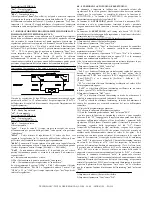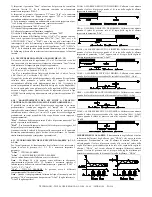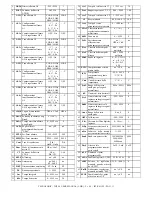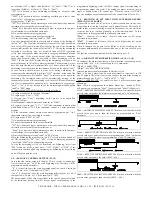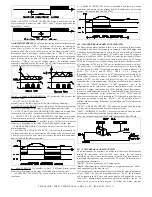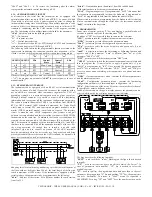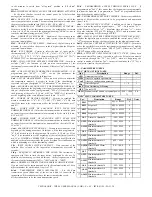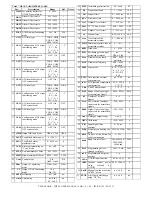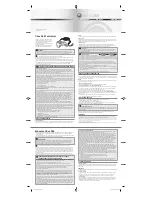
last page of this instruction manual and push then "P" key. If the password
entered is wrong, the instrument go back to the previous control state.
P.A. :
Always go regularly out from the programming phase because, if the
instrument is switched off during the programming, at the next start-up
could
be signalled the memory error "Err EEPr", To re-establish the
functioning occurs then to push "LEFT" key.
6 - PARAMETERS
DESCRIPTION
Here following are described all the instrument parameters; pls. note that
some of them could do not appear or because are according to the kind of
used instrument or because are automatically not qualified, as they're not
necessary.
- "OPEr" MENU
SEt1
- SET POINT 1: Control value of Set Point n.1
SEt2
- SET POINT 2: Control value of Set Point n.2
SEt3
- SET POINT 3: Control value of Set Point n.3
SEt4
- SET POINT 4: Control value of Set Point n.4
AL1
- ALARM A1 THRESHOLD : A1 alarm threshold for minimum or
maximum alarms.
AL1L
- MINIMUM ALARM A1 THRESHOLD : A1 alarm threshold
working as minimum alarm when it's set a window alarm type.
AL1H
- MAXIMUM ALARM A1 THRESHOLD : A1 alarm threshold
working as maximum alarm when it's set a window alarm type.
AL2
- ALARM A2 THRESHOLD : Equal to "AL1", but referred to A2
alarm.
AL2L
- MINIMUM ALARM A2 THRESHOLD : Equal to "AL1L", but
referred to A2 alarm.
AL2H
- MAXIMUM ALARM A2 THRESHOLD : Equal to "AL1H", but
referred to A2 alarm.
ALHb
- HEATER BREAK ALARM THRESHOLD :
Activation set of
Heater Break alarm.
AL3
- ALARM A3 THRESHOLD : Equal to "AL1", but referred to A3
alarm.
AL3L
- MINIMUM ALARM A3 THRESHOLD : Equal to "AL1L", but
referred to A3 alarm.
AL3H
- MAXIMUM ALARM A3 THRESHOLD : Equal to "AL1H", but
referred to A3 alarm.
AL4
- ALARM A4 THRESHOLD : Equal to "AL1", but referred to A4
alarm.
AL4L
- MINIMUM ALARM A4 THRESHOLD : Equal to "AL1L", but
referred to A4 alarm.
AL4H
- MAXIMUM ALARM A4 THRESHOLD : Equal to "AL1H", but
referred to A4 alarm.
- "ConF" MENU
HSEt
- SET POINT HYSTERESIS : Semi-band relative to the Set Point,
which decides the C1 outputs activation and deactivation values when the
control mode is ON/OFF.
HAL1
- ALARM A1 HYSTERESIS : Asymmetric semi-band referred to A1
alarm value, that establish the deactivation value of A1 alarm.
HAL2
- ALARM A2 HYSTERESIS : Equal to "HAL1", but referred to A2
alarm.
HAL3
- ALARM A3 HYSTERESIS : Equal to "HAL1", but referred to A3
alarm.
HAL4
- ALARM A4 HYSTERESIS : Equal to "HAL1", but referred to A4
alarm.
FAL3
- A3/HB OUTPUT FUNCTIONING MODE : Permits to establish if
A3/HB output has to operate as alarm ("AL3") or Heater Break alarm
("Hb").
AL1t
- A1 ALARM TYPE : Permit to establish the type of A1 alarm (see
alarm output functioning mode)
AL1c
- CONFIGURATION OF A1 ALARM FUNCTIONING MODE :
Permit to establish the functioning mode of A1 alarm (see alarm output
functioning mode)
AL1o
- A1 ALARM BEHAVIOUR IN OFF CONTROL MODE : Permit to
establish if in "OFF" control mode the alarm has to be active ("On") or not
active ("OFF")
AL2t
- A2 ALARM TYPE : Equal to "AL1t", but referred to A2 alarm.
AL2c
- CONFIGURATION OF A2 ALARM FUNCTIONING MODE :
Equal to "AL1c", but referred to A2 alarm.
AL2o
- A2 ALARM BEHAVIOUR IN OFF CONTROL MODE :
Equal to
"AL1o", but referred to A2 alarm.
AL3t
- A3 ALARM TYPE : Equal to "AL1t", but referred to A3 alarm.
AL3c
- CONFIGURATION OF A3 ALARM FUNCTIONING MODE :
Equal to "AL1c", but referred to A3 alarm.
AL3o
- A3 ALARM BEHAVIOUR IN OFF CONTROL MODE :
Equal to
"AL1o", but referred to A3 alarm.
AL4t
- A4 ALARM TYPE : Equal to "AL1t", but referred to A4 alarm.
AL3c
- CONFIGURATION OF A4 ALARM FUNCTIONING MODE :
Equal to "AL1c", but referred to A4 alarm.
AL4o
- A4 ALARM BEHAVIOUR IN OFF CONTROL MODE :
Equal to
"AL1o", but referred to A4 alarm.
rLHb
- OUTPUT HB LOGIC MODE : Permits to establish the Heater
Break alarm (A3/HB) functioning mode, setting the output rest state ("nO"
= normally deactivated, "nC" = normally activated)
LbAP -
LOOP BREAK ALARM POWER : Value of C1 output power (in
%); if it is exceeded, intervene the time counting programmed on par.
"LbAt" that active the Loop Break alarm.
AbAt -
LOOP BREAK ALARM MAX. TIME : Maximum time that the power
programmed on par. "LbAP" can be applicable on the load (in sec.) before
that Loop Break alarm intervene
ALPr
- ALARMS PROGRAMMING ON "CONF" MENU : Permits to make
visible the alarm setting parameters on "OPEr" menu ("no") or on "ConF"
menu ("yES").
SPLL
- LOW/MINIMUM SET POINT : Minimum possible Set Point value
or lower limit of Set point.
SPHL
- HIGH/MAXIMUM SET POINT : Maximum possible Set Point
value or higher limit of Set point.
Cont
- CONTROL MODE : Permits to select one of the possible control
mode offered by the instrument : ON/OFF with symmetric hysteresis
("OnFS"), ON/OFF with asymmetric hysteresis ("OnFa") or PID ("Pid").
Func -
OUTPUT C1 OPERATING MODE : Permits to decide if C1
control mode has to act a reverse action, as an Heating process ("HEAt")
or a direct action, as a Cooling process ("CooL"). If it's desired to use the
PID control mode for motorised actuators, program the parameter as
"HEAt".
C2 -
C2/A4 OUTPUT FUNCTIONING MODE : Permits to establish if
C2/A4 output has to operate as alarm ("AL4") or as C2 output fot
motorised actuators ("3Pt").
SELF
- SELFTUNING: Parameter to enable (yES) or disable (no) of the
Selftuning function which allows the continuous counting of the PID
regulator parameters, during the process control.
Auto
- AUTOTUNING: Selection parameter used to enable on "SEL" menu
the option "tunE" , that permits to carry on the Autotuning cycle to
automatically tune the right PID regulation parameters. It's possible to
perform the Autotuning FAST type ("FaSt") or oscillatory type respect to
the effective value of the Set Point ("SP") or to a reduced value equal to
70% of the Set Point ("LoSP"). If it's not desired to have the Autotuning,
set "no".
PidP -
AUTOTUNING OPTIMISATION : Permits to select an autotuning
cycle to optimise the calculated parameters for eventual Set point
variations ("SP") or to optimise the calculated parameters for eventual
variations of the controlled plant load variations ("Load")
Pb
- PROPORTIONAL BAND : Band width around Set Point on which
works the proportional control.
Int
- INTEGRAL TIME : Integral time to be set in the PID regulation
algorithm, expressed in seconds.
dEr
- DERIVATIVE TIME : Derivative time to be set in the PID regulation
algorithm, expressed in seconds.
tcr1
- OUTPUT C1 CYCLE TIME : Cycle time referred to C1 output , when
intervenes the proportional regulation on PID control mode, expressed in
seconds.
Prat
- C2 / C1 POWER RATIO : Setting of power ratio between the
element controlled by C2 output (ex, Cooler) and power of the element
controlled by C1 output (ex. Heater) when the instrument works with
double action PID control.
tcr2
- OUTPUT C2 CYCLE TIME : Cycle time referred to C2 output , when
intervenes the proportional regulation on PID regulation mode, expressed
in seconds.
rS
- MANUAL RESET : Proportional band positioning referred to the Set
Point, expressed in percentage value.
tcor
- TRAVEL TIME OF THE MOTORISED ACTUATOR : On this
parameter is to be programmed the time, expressed in seconds, that occur
TECNOLOGIC - THP 94
USER MANUAL (I - GB) - Vr. 05 - ISTR 01195 - PAG. 19

